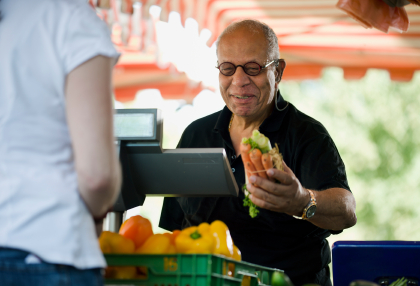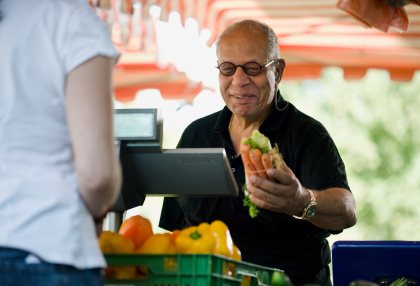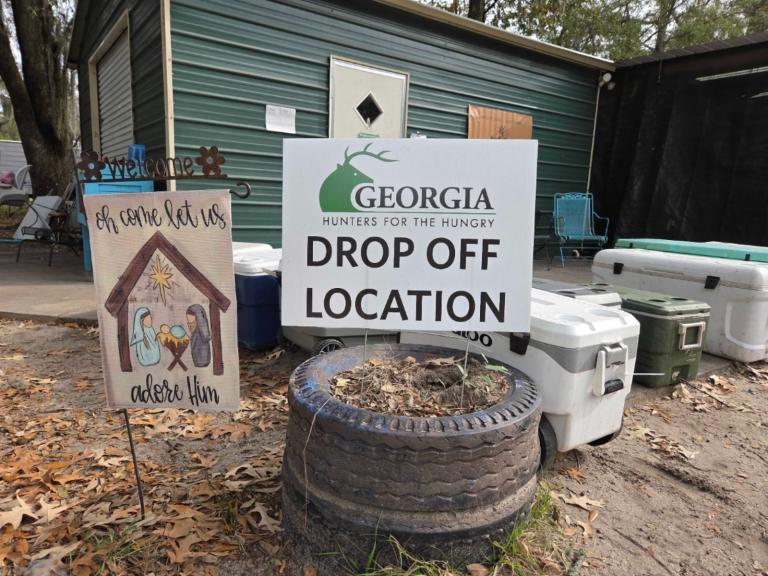 A delicious investment. The USDA released its latest Farmers Market Survey last week, showing 7,175 farmers markets across the country, up 17 percent from last year. This news led USDA Deputy Secretary Kathleen Merrigan to declare:
A delicious investment. The USDA released its latest Farmers Market Survey last week, showing 7,175 farmers markets across the country, up 17 percent from last year. This news led USDA Deputy Secretary Kathleen Merrigan to declare:
The growth in farmers markets is a sign that the local and regional food system is robust and thriving. More farmers markets mean more opportunities for small and midsize farmers — especially beginning farmers — to diversify their farms, sell their products, and grow their businesses. More farmers markets mean more local economic stimulation to more communities which, in turn, mean more job opportunities. More farmers markets mean more access to fresh, healthy, and local food.
Secure · Tax deductible · Takes 45 SecondsSecure · Tax deductible · Takes 45 Seconds
Providing support to that argument is a new report from the Union of Concerned Scientists called “Market Forces: Creating Jobs through Public Investment in Local and Regional Food Systems.” It argues that farmers markets and — more significantly — “the local and regional food systems behind them” can be a significant source of job growth with minimal investment.
The report is actually about far more than farmers markets. Report author Jeffrey O’Hara uses farmers markets as a proxy for the whole concept of local and regional distribution of food. And it turns out that, with proper support, growing and distributing fruit and vegetables either directly to consumers or through regional food hubs can represent a real job engine for both rural and urban areas.
The report suggests that government support for new and struggling farmers markets is particularly effective. It states that “modest public funding for 100 to 500 otherwise-unsuccessful farmers markets a year could create as many as 13,500 jobs over a five-year period.” But that’s a floor for job growth rather than a ceiling. Just as significant is support for other local-food institutions such as food hubs and farm-to-school programs — indeed, these kinds of initiatives are what will allow local food systems to scale. More ambitiously, the report also calls for an expansion of farm credit availability to small farmers and changes in the federal crop insurance program to include more “whole farm” coverage rather than the current system which is focused on commodity crops such as corn, wheat, soy, and cotton.
The report also highlights the effectiveness of the USDA’s Know Your Farmer, Know Your Food (KYF2) program, which is a clearinghouse for the USDA efforts on farmers markets, food hubs, and farm-to-school programs. While it’s nice to think that KYF2 could represent the vanguard in a new wave of agricultural job growth, note that the House GOP has already targeted KYF2 for elimination. And I somehow doubt that the Union of Concerned Scientists will do much to change their minds.
In fact, the best option for growing the local and regional food system may be through “locavesting,” or, as Fast Company describes it, “the movement to rebuild sustainable communities by investing in businesses within 50 miles of where you live.” Like farmers markets, locavesting is a back-to-the-future trend, as Amy Cortese, former BusinessWeek editor and author of a book on the subject, explains:
From the earliest days of the country, investments were local. There were informal networks of investors and merchants, and that’s how industries were built, how regions prospered, and local stock exchanges turbocharged that. But since the 1930s when our securities regulations were largely put into place, it’s gone in a different direction. After the Great Depression they created laws that governed how you could invest and trade. That had the unintended consequence of hampering a lot of local investment.
But now a new wave of investors are turning their attention back to Main Street. And appropriately enough, one of Cortese’s prime examples of successful locavesting is Hardwick, Vt., known as “the town that food saved”:
It started when the area’s new generation of farmers and entrepreneurs began getting together to help each other work through business issues. Many of them, such as Tom Stearns of High Mowing Seeds and Pete Johnson of Pete’s Greens, were experiencing rapid growth and would run into cash flow problems, so they began lending money to each other to get through lean times. Around 2005, Stearns raised $1.1 million from a group of (accredited) local investors, all within 50 miles. Other community investments followed. Claire’s Restaurant, which showcases food grown or raised by the area’s farmers, sold prepaid “food coupons” to 50 residents for $1,000 apiece, which entitled them to $25 off a meal once a month for four years. It’s sort of modern day barn raising. All of this mutual support and reinforcement has attracted more entrepreneurs to Hardwick, like the Vermont Food Venture Center, a shared use facility for food producers and startups, which has relocated to Hardwick from Burlington to be part of the action. In the last three years, while most of the country was struggling with unemployment, Hardwick created 100 food and agriculture-related jobs, increasing local jobs by 25 percent.
Now, Hardwick is going through growing pains, as this recent NPR report documented, but that’s a far cry from failing, and it’s still outgrowing many regions in the Northeast.
[UPDATED:] In all my excitement, I neglected to point out the main irony in all this: That the development of industrial agriculture has been as much about job destruction as it has been about increases in productivity. Most of the techniques of intensive, mechanized, chemical-based food production have ended up displacing workers. In some ways, this has been a positive change since much of farmwork is backbreaking stuff; it’s easy to sit at my keyboard and write a paean to “honest manual labor.” At the same time, much of this displacement has been to what might be considered management positions — owners and operators of farms. Advocates for local food systems (including the USDA folks behind KYF2) understand all this very well — but it’s nice to see a comprehensive look at the way these kinds of reforms can undo some of the job destruction damage.
In the end, one thing is clear with every passing day and every sign of further intransigence from a Republican Party dedicated to halting American progress on any and all fronts: It will be up to Main Street itself, not Wall Street or Capitol Hill, to figure out a way to make local markets grow. The good news is that the numbers — both people and profits — are turning out to be on our side.




